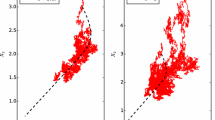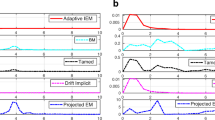Abstract
A class of implicit Milstein type methods is introduced and analyzed in the present article for stochastic differential equations (SDEs) with non-globally Lipschitz drift and diffusion coefficients. By incorporating a pair of method parameters \(\theta , \eta \in [0, 1]\) into both the drift and diffusion parts, the new schemes are indeed a kind of drift-diffusion double implicit methods. Within a general framework, we offer upper mean-square error bounds for the proposed schemes, based on certain error terms only getting involved with the exact solution processes. Such error bounds help us to easily analyze mean-square convergence rates of the schemes, without relying on a priori high-order moment estimates of numerical approximations. Putting further globally polynomial growth condition, we successfully recover the expected mean-square convergence rate of order one for the considered schemes with \(\theta \in [\tfrac{1}{2}, 1], \eta \in [0, 1]\). Also, some of the proposed schemes are applied to solve three SDE models evolving in the positive domain \((0, \infty )\). More specifically, the particular drift-diffusion implicit Milstein method (\( \theta = \eta = 1 \)) is utilized to approximate the Heston \(\frac{3}{2}\)-volatility model and the stochastic Lotka-Volterra competition model. The semi-implicit Milstein method (\(\theta =1, \eta = 0\)) is used to solve the Ait-Sahalia interest rate model. Thanks to the previously obtained error bounds, we reveal the optimal mean-square convergence rate of the positivity preserving schemes under more relaxed conditions, compared with existing relevant results in the literature. Numerical examples are also reported to confirm the previous findings.
Similar content being viewed by others
Change history
20 June 2023
A Correction to this paper has been published: https://doi.org/10.1007/s10444-023-10056-w
References
Ait-Sahalia, Y.: Testing continuous-time models of the spot interest rate. The Review of Financial Studies 9(2), 385–426 (1996)
Alfonsi, A.: Strong order one convergence of a drift implicit Euler scheme: Application to the CIR process. Statistics & Probability Letters 83(2), 602–607 (2013)
Andersson, A., Kruse, R.: Mean-square convergence of the BDF2-Maruyama and backward Euler schemes for SDE satisfying a global monotonicity condition. BIT Numerical Mathematics 57(1), 21–53 (2017)
Beyn, W.-J., Isaak, E., Kruse, R.: Stochastic C-stability and B-consistency of explicit and implicit Euler-type schemes. Journal of Scientific Computing 67(3), 955–987 (2016)
Beyn, W.-J., Isaak, E., Kruse, R.: Stochastic C-stability and B-consistency of explicit and implicit Milstein-type schemes. Journal of Scientific Computing 70(3), 1042–1077 (2017)
Bossy, M., Quinteros, H.O.: Strong convergence of the symmetrized Milstein scheme for some CEV-like SDEs. Bernoulli 24(3), 1995–2042 (2015)
Buckwar, E., Sickenberger, T.: A comparative linear mean-square stability analysis of Maruyama- and Milstein-type methods. Mathematics & Computers in Simulation 81(6), 1110–1127 (2011)
Kahl, C., Gunther, M., Rosberg, T.: Structure preserving stochastic integration schemes in interest rate derivative modeling. Applied Numerical Mathematics 58, 284–295 (2008)
Chassagneux, J., Jacquier, A., Mihaylov, I.: An explicit Euler scheme with strong rate of convergence for financial SDEs with non-lipschitz coefficients. SIAM Journal on Financial Mathematics 7(1), 993–1021 (2016)
Cui, J., Hong, J., and Sheng, D. (2019) Convergence in density of splitting AVF scheme for stochastic Langevin equation. arXiv:1906.03439
Ahn, D.H., Gao, B.: A parametric nonlinear model of term structure dynamics. Review of Financial Studies 12, 721 (1999)
Fang, W., Giles, M.B.: Adaptive Euler-Maruyama method for SDEs with nonglobally Lipschitz drift. Ann. Appl. Probab. 30(2), 526–560 (2020)
Gan, S., He, Y., Wang, X.: Tamed Runge-Kutta methods for SDEs with super-linearly growing drift and diffusion coefficients. Appl. Numer. Math. 152, 379–402 (2020)
Giles, M.B.: Improved multilevel Monte Carlo convergence using the Milstein scheme. In: Keller, A., Heinrich, S., Niederreiter, H. (eds.) Monte Carlo and Quasi-Monte Carlo Methods 2006. Springer, Berlin, Heidelberg (2008)
Giles, M.: Multilevel monte carlo path simulation. Oper. Res. 56, 607–617 (2008)
Giles, M., Debrabant, K., Rößler A.: Analysis of multilevel monte carlo path simulation using the milstein discretisation. Discrete Cont Dyn-B, 24(8), 3881–3903 (2019)
Gilsing, H., Shardlow, T.: Sdelab: A package for solving stochastic differential equations in matlab. Journal of Computational and Applied Mathematics 205(2), 1002–1018 (2007)
Guo, Q., Liu, W., Mao, X., Yue, R.: The truncated Milstein method for stochastic differential equations with commutative noise. Journal of Computational and Applied Mathematics 338, 298–310 (2018)
Heston, S.: A simple new formula for options with stochastic volatility. Course Notes of Washington University in St, Louis, Missouri (1997)
Higham, D.J., Mao, X., Stuar, A.M.: Strong convergence of Euler-type methods for nonlinear stochastic differential equations. SIAM Journal on Numerical Analysis 40(3), 1041–1063 (2002)
Higham, D.J., Mao, X., Szpruch, L.: Convergence, non-negativity and stability of a new Milstein scheme with applications to finance. Discrete & Continuous Dynamical Systems-Series B 18(8), 2083–2100 (2013)
Hu, Y.: Semi-implicit euler-maruyama scheme for stiff stochastic equations. in Stochastic Analysis and Related Topics V: The Silvri Workshop. Progr. Probab. 38, 183–202 (1996)
Hutzenthaler, M. and Jentzen, A. (2015) Numerical approximation of stochastic differential equations with non-globally Lipschitz continuous coefficients. Mem. Amer. Math. Soc., 236(1112)
Hutzenthaler, M., Jentzen, A.: On a perturbation theory and on strong convergence rates for stochastic ordinary and partial differential equations with non-globally monotone coefficients. Ann. Probab. 48(1), 53–93 (2020)
Hutzenthaler, M., Jentzen, A., Kloeden, P.E.: Strong and weak divergence in finite time of Euler’s method for stochastic differential equations with non-globally Lipschitz continuous coefficients. Proceedings of the Royal Society of London A: Mathematical, Physical and Engineering Sciences 467(2130), 1563–1576 (2011)
Hutzenthaler, M., Jentzen, A., Kloeden, P.E.: Strong convergence of an explicit numerical method for SDEs with nonglobally Lipschitz coefficients. Ann. Appl. Probab. 22(4), 1611–1641 (2012)
Hutzenthaler, M., Jentzen, A., Wang, X.: Exponential integrability properties of numerical approximation processes for nonlinear stochastic differential equations. Math. Comput. 87(311), 1353–1413 (2018)
Kelly, C., Lord, G., and Sun, F. (2019) Strong convergence of an adaptive time-stepping Milstein method for SDEs with one-sided Lipschitz drift. arXiv:1909.00099
Kelly, C., Lord, G.J.: Adaptive time-stepping strategies for nonlinear stochastic systems. IMA Journal of Numerical Analysis 38(3), 1523–1549 (2017)
Kloeden, P.E., and Platen, E. (1992) Numerical solution of stochastic differential equations, vol 23. Springer Science & Business Media
Kruse, R., Wu, Y.: A randomized Milstein method for stochastic differential equations with non-differentiable drift coefficients. Discrete & Continuous Dynamical Systems-B 24(8), 3475–3502 (2019)
Kumar, C., Sabanis, S.: On Milstein approximations with varying coefficients: the case of super-linear diffusion coefficients. BIT Numerical Mathematics 59(4), 929–968 (2019)
Lewis, A.L., (2000) Option valuation under stochastic volatility. Finance Press
Li, X., Yin, G.: Explicit Milstein schemes with truncation for nonlinear stochastic differential equations: convergence and its rate. J. Comput. Appl. Math. 374, 112771 (2020)
Liu, Z., Qiao, Z.: Strong approximation of monotone stochastic partial differential equations driven by multiplicative noise. Stochastics and Partial Differential Equations: Analysis and Computations 9(3), 559–602 (2021)
Majee, A.K., Prohl, A.: Optimal strong rates of convergence for a space-time discretization of the stochastic allen-cahn equation with multiplicative noise. Computational Methods in Applied Mathematics 18(2), 297–311 (2018)
Mao, X.: The truncated Euler-Maruyama method for stochastic differential equations. J. Comput. Appl. Math. 290, 370–384 (2015)
Mao, X.: Convergence rates of the truncated Euler-Maruyama method for stochastic differential equations. J. Comput. Appl. Math. 296, 362–375 (2016)
Mao, X., Szpruch, L.: Strong convergence and stability of implicit numerical methods for stochastic differential equations with non-globally Lipschitz continuous coefficients. J. Comput. Appl. Math. 238, 14–28 (2013)
Mao, X., Szpruch, L.: Strong convergence rates for backward Euler-Maruyama method for non-linear dissipative-type stochastic differential equations with super-linear diffusion coefficients. Stochastics An International Journal of Probability and Stochastic Processes 85(1), 144–171 (2013)
Mao, X., Wei, F., Wiriyakraikul, T.: Positivity preserving truncated euler-maruyama method for stochastic lotka-volterra competition model. Journal of Computational and Applied Mathematics 394, 113566 (2011)
Milstein, G.N., Platen, E., Schurz, H.: Balanced implicit methods for stiff stochastic systems. SIAM J. Numer. Anal. 35(3), 1010–1019 (1998)
Milstein, G.N., and Tretyakov, M.V. (2013) Stochastic numerics for mathematical physics. Springer Science & Business Media
Neuenkirch, A., Szpruch, L.: First order strong approximations of scalar sdes defined in a domain. Numerische Mathematik 128(1), 103–136 (2014)
Rößler, A.: Runge-kutta methods for the strong approximation of solutions of stochastic differential equations. SIAM J. Numer. Anal. 48(3), 922–952 (2010)
Sabanis, S.: A note on tamed Euler approximations. Electron. Commun. Probab 18(47), 1–10 (2013)
Sabanis, S.: Euler approximations with varying coefficients: the case of super-linearly growing diffusion coefficients. Ann. Appl. Probab. 26(4), 2083–2105 (2016)
Szpruch, L., Mao, X., Higham, D.J., Pan, J.: Numerical simulation of a strongly nonlinear Ait-Sahalia-type interest rate model. BIT Numerical Mathematics 51(2), 405–425 (2011)
Szpruch, L., Zhang, X.: V-integrability, asymptotic stability and comparison property of explicit numerical schemes for non-linear SDEs. Math. Comput. 87(310), 755–783 (2018)
Tretyakov, M.V., Zhang, Z.: A fundamental mean-square convergence theorem for SDEs with locally Lipschitz coefficients and its applications. SIAM J. Numer. Anal. 51(6), 3135–3162 (2013)
Wang, X., Gan, S.: The tamed Milstein method for commutative stochastic differential equations with non-globally Lipschitz continuous coefficients. Journal of Difference Equations and Applications 19(3), 466–490 (2013)
Wang, X., Wu, J., Dong, B.: Mean-square convergence rates of stochastic theta methods for SDEs under a coupled monotonicity condition. BIT Numer. Math. 60(3), 759–790 (2020)
Wang, X., Gan, S., Wang, D.: A family of fully implicit milstein methods for stiff stochastic differential equations with multiplicative noise. BIT Numer. Math. 52(3), 741–772 (2012)
Wiktorsson, M.: Joint characteristic function and simultaneous simulation of iterated itô integrals for multiple independent brownian motions. The Annals of Applied Probability 11(2), 470–487 (2001)
Yao, J., Gan, S.: Stability of the drift-implicit and double-implicit milstein schemes for nonlinear sdes. Appl. Math. Comput. 339, 294–301 (2018)
Zhang, Z., Ma., H.: Order-preserving strong schemes for SDEs with locally Lipschitz coefficients. Appl. Numer. Math. 112, 1–16 (2017)
Zong, X., Wu, F., Xu, G.: Convergence and stability of two classes of theta-Milstein schemes for stochastic differential equations. J. Comput. Appl. Math. 336, 8–29 (2018)
Funding
This work was supported by Natural Science Foundation of China (12071488, 11971488) and Natural Science Foundation of Hunan Province for Distinguished Young Scholars (2020JJ2040).
Author information
Authors and Affiliations
Corresponding author
Ethics declarations
Conflict of interest
The author declares no competing interests.
Additional information
Communicated by: Ivan Oseledets
Publisher's Note
Springer Nature remains neutral with regard to jurisdictional claims in published maps and institutional affiliations.
The original online version of this article was revised: the affiliation detail for Xiaojie Wang was incorrectly given as “School of Mathematics and Statistics, HNP-LAMA Institute for Metal Physics, National Academy of Sciences” but should have been “School of Mathematics and Statistics, HNP-LAMA, Central South University”.
Rights and permissions
Springer Nature or its licensor (e.g. a society or other partner) holds exclusive rights to this article under a publishing agreement with the author(s) or other rightsholder(s); author self-archiving of the accepted manuscript version of this article is solely governed by the terms of such publishing agreement and applicable law.
About this article
Cite this article
Wang, X. Mean-square convergence rates of implicit Milstein type methods for SDEs with non-Lipschitz coefficients. Adv Comput Math 49, 37 (2023). https://doi.org/10.1007/s10444-023-10034-2
Received:
Accepted:
Published:
DOI: https://doi.org/10.1007/s10444-023-10034-2
Keywords
- Stochastic differential equations
- Implicit Milstein type methods
- Mean-square convergence rates
- Heston \(\frac{3}{2}\)-volatility model
- Ait-Sahalia interest rate model
- Stochastic lotka-volterra competition model
- Positivity preserving schemes




